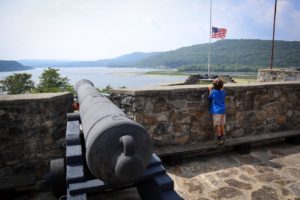Disclosure: This post may contain affiliate links. If you click a link and purchase a recommended item, I may receive a commission, although there is no additional cost to you.
In late 1775, the Continental Army held the high ground surrounding Boston, Massachusetts — but it wasn’t much of a siege. The British retained access to the harbor, and all the commerce and resupply that implies. And, without a single cannon, General George Washington lacked any means to threaten his enemy’s position. That isn’t to say the rebellious colonies possessed no artillery; it just wasn’t anywhere particularly useful to them.
 Some 240 miles away in upstate New York, hundreds of cannons sat at Fort Ticonderoga — a bastion along the portage between Lack Champlain and Lake George that had proved to be of strategic significance to both the British and French throughout the colonial period. That spring, upon hearing of the fighting at Lexington and Concord, two separate bands of patriots — Ethan Allen and Vermont’s Green Mountain Boys, and the years-from-turning-traitorous Benedict Arnold — had both headed there and seized the garrison without bloodshed.
Some 240 miles away in upstate New York, hundreds of cannons sat at Fort Ticonderoga — a bastion along the portage between Lack Champlain and Lake George that had proved to be of strategic significance to both the British and French throughout the colonial period. That spring, upon hearing of the fighting at Lexington and Concord, two separate bands of patriots — Ethan Allen and Vermont’s Green Mountain Boys, and the years-from-turning-traitorous Benedict Arnold — had both headed there and seized the garrison without bloodshed.
But with forests, rivers and mountains separating them from his troops, those cannons were of no good to Washington. It took the daring and outside-the-box thinking of a bookseller and self-taught soldier to figure out how to bridge the distance. Henry Knox made use of boats and sleds to conquer the terrain and the winter weather. That March, when the British saw the strength of the Continental artillery that had been assembled at Boston, they evacuated without a shot being fired.
Today, Fort Ticonderoga is a privately administered historic site with something to offer the whole family: manicured historic gardens, boating expeditions on the lake, corn mazes, museum exhibits, living history demonstrations, hiking across the 2,000-acre property and more. It is seasonally operated (May to October) because the passing of two centuries hasn't changed the fact that the winters are harsh and tourism is a summer industry. But there are events in the colder months, including reenactments of the 1757 and 1758 Battles on Snowshoes.
As with any such historic site, it’s the interaction with living historians that make or break the experience for children, and Fort Ticonderoga’s were very good. By virtue of the site’s military connections, the vast majority of interpreters were “in uniform,” as opposed to civilians, but this didn’t pose an obstacle to my boys whatsoever. Historic trades were well represented and there were plenty of chances for hands on and participatory interaction.
 Interestingly, the site’s interpretive model takes an innovative approach that makes repeat visits worthwhile. Via a rotation across several years, the fort is interpreted from a variety of different perspectives. Thus, one summer, you might enter the French Fort Carillon during 1757, and two years later find Americans of the Revolutionary era ensconced there. During our visit, the fort was occupied by the British. I thought it was a really interesting idea to encourage locals to attend regularly and to draw tourists back across seasons, and not one I’d seen executed well elsewhere.
Interestingly, the site’s interpretive model takes an innovative approach that makes repeat visits worthwhile. Via a rotation across several years, the fort is interpreted from a variety of different perspectives. Thus, one summer, you might enter the French Fort Carillon during 1757, and two years later find Americans of the Revolutionary era ensconced there. During our visit, the fort was occupied by the British. I thought it was a really interesting idea to encourage locals to attend regularly and to draw tourists back across seasons, and not one I’d seen executed well elsewhere.
As a preservationist at heart, I also found the story of how the site came to be protected and, eventually, opened to the public fascinating. After losing its military significance following the Saratoga Campaign, Ticonderoga gradually fell into disrepair, and parts were in ruins by the time the Pell Family acquired the area in 1820 to be used as a private vacation retreat. Thanks to the advent or railroads, the Pells began restoring the fort as a tourist destination, opening to the public in 1909. The Fort Ticonderoga Association was founded in 1931 and owns the site today and restorations are ongoing.
Verdict: Fort Ticonderoga is absolutely worth a visit from your family, if you are remotely in the area. The whole region of upstate New York and Vermont is beautiful, and a great destination to escape oppressive summer heat, so consider it a mark solidly in the "pro" column if you're weighing a trip to the area.

